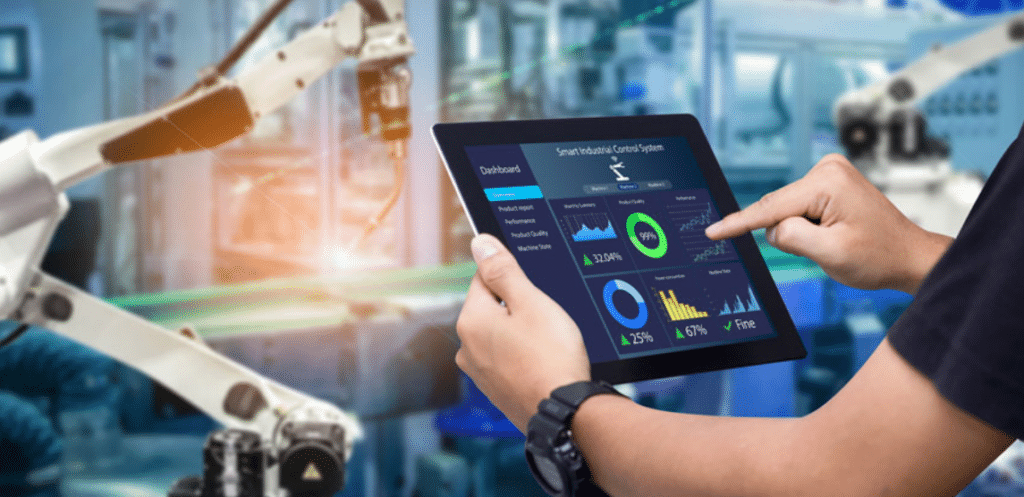The Role of Manufacturing Software in Modern Industry – The manufacturing industry has undergone significant transformations over the past few decades. From the early days of the Industrial Revolution to the current era of Industry 4.0, advancements in technology have continuously redefined the landscape of manufacturing. One of the most significant contributors to this transformation is the advent of manufacturing software.

Understanding Manufacturing Software
Manufacturing software refers to a collection of applications and tools designed to facilitate and streamline various aspects of the manufacturing process. These tools can range from simple inventory management systems to complex enterprise resource planning (ERP) solutions that integrate all facets of a manufacturing operation, including production planning, procurement, quality control, and sales.
Types of Manufacturing Software
There are several types of manufacturing software, each catering to specific needs within the industry:
- Enterprise Resource Planning (ERP) Software: ERP software integrates various functions of a manufacturing enterprise into a unified system. It helps manage resources, monitor production schedules, track inventory, and ensure compliance with regulatory standards. Popular ERP solutions include SAP, Oracle, and Microsoft Dynamics.
- Manufacturing Execution Systems (MES): MES software provides real-time data on the production floor. It helps monitor and control manufacturing operations, ensuring that production processes are carried out efficiently and accurately. Examples of MES software include Siemens SIMATIC IT, Rockwell Automation’s FactoryTalk, and GE Digital’s Proficy.
- Product Lifecycle Management (PLM) Software: PLM software manages the entire lifecycle of a product, from its initial design to its eventual disposal. It helps coordinate activities across different departments, ensuring that everyone is working with the most up-to-date information. Examples of PLM software include PTC Windchill, Dassault Systèmes’ ENOVIA, and Siemens Teamcenter.
- Computer-Aided Design (CAD) Software: CAD software is used to create precise drawings and models of products. It allows engineers and designers to visualize and test their ideas before they are manufactured. Popular CAD tools include AutoCAD, SolidWorks, and CATIA.
- Computer-Aided Manufacturing (CAM) Software: CAM software converts CAD designs into machine-readable instructions. It helps automate the production process, reducing the need for manual intervention. Examples of CAM software include Mastercam, HyperMill, and Autodesk Fusion 360.
Benefits of Manufacturing Software
The adoption of manufacturing software offers numerous benefits to businesses:
- Increased Efficiency: Manufacturing software automates routine tasks, freeing up employees to focus on more strategic activities. This leads to increased productivity and faster production cycles.
- Improved Quality Control: With real-time monitoring and data analysis, manufacturing software helps identify and address quality issues promptly. This results in fewer defects and higher-quality products.
- Enhanced Visibility: Manufacturing software provides a comprehensive view of the entire production process. This visibility allows managers to make informed decisions and respond quickly to changing circumstances.
- Cost Savings: By optimizing resource usage and reducing waste, manufacturing software helps lower operational costs. Additionally, it can minimize the need for manual labour, further reducing expenses.
- Regulatory Compliance: Many industries are subject to strict regulatory requirements. Manufacturing software helps ensure compliance by tracking and documenting all relevant activities.
Challenges and Considerations
While the benefits of manufacturing software are significant, there are also challenges to consider:
- Implementation Costs: The initial investment in manufacturing software can be substantial. Businesses must weigh the costs against the potential long-term benefits.
- Integration with Existing Systems: Integrating new software with existing systems can be complex and time-consuming. It may require significant customization and training.
- Data Security: As manufacturing processes become more digitized, the risk of cyberattacks increases. Businesses must implement robust security measures to protect sensitive information.
- Employee Training: The successful adoption of manufacturing software requires proper training for employees. This can be a time-consuming and costly process, but it is essential for ensuring that the software is used effectively.
Future Trends in Manufacturing Software
The manufacturing software landscape is continuously evolving. Several trends are shaping the future of the industry:
- Artificial Intelligence (AI) and Machine Learning: AI and machine learning technologies are being integrated into manufacturing software to enhance predictive maintenance, quality control, and production optimization. These technologies can analyze vast amounts of data to identify patterns and make recommendations.
- Internet of Things (IoT): IoT devices are increasingly being used to collect real-time data from manufacturing equipment. This data can be analyzed to improve efficiency, reduce downtime, and enhance product quality.
- Cloud Computing: Cloud-based manufacturing software offers several advantages, including scalability, cost-effectiveness, and remote accessibility. It allows businesses to access and share information from anywhere in the world.
- Augmented Reality (AR) and Virtual Reality (VR): AR and VR technologies are being used to improve training, design, and maintenance processes. For example, AR can provide workers with real-time instructions and guidance, while VR can be used to simulate production environments for training purposes.
- Blockchain Technology: Blockchain technology offers a secure and transparent way to track and verify transactions in the supply chain. It can help prevent fraud, reduce errors, and enhance trust between partners.
Conclusion
Manufacturing software plays a crucial role in modern industry by streamlining operations, improving quality control, and reducing costs. While there are challenges to implementing and integrating these solutions, the benefits far outweigh the drawbacks. As technology continues to advance, manufacturing software will become even more sophisticated, helping businesses stay competitive in an ever-changing market. By staying abreast of the latest trends and investing in the right tools, manufacturers can position themselves for success in the future.

